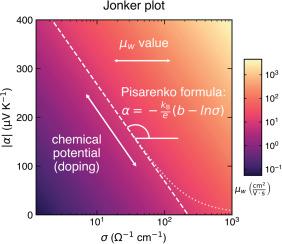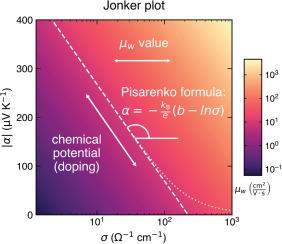Revisiting Pisarenko’s formula: Effective mass estimation, thermopower–conductivity relation, and maximum power factor prediction
IF 9.7
2区 材料科学
Q1 MATERIALS SCIENCE, MULTIDISCIPLINARY
引用次数: 0
Abstract
The thermopower (also known as the Seebeck coefficient) is one of the most fundamental material characteristics for understanding charge carrier transport in thermoelectric materials. Here, we revisit the Pisarenko formula for the thermopower, which was traditionally considered valid only for non-degenerate semiconductors. We demonstrate that regardless of the dominating scattering mechanism, the Pisarenko formula describes accurately enough the relationship between thermopower and charge carrier concentration beyond the non-degenerate limit. Moreover, the Pisarenko formula provides a simple thermopower–conductivity relation, , where is a constant determined by the scattering mechanism and weighted mobility , and is the electrical conductivity. This relation is valid for materials with when acoustic phonon scattering is predominant. This offers an alternative way to analyze electron transport when Hall measurements are difficult or inaccessible. Additionally, we show how the Pisarenko formula can be used to estimate the maximum power factor of a thermoelectric material from the weighted mobility of a single, not necessarily optimized, sample at any given temperature.


重温Pisarenko的公式:有效质量估计,热电功率-电导率关系,和最大功率因数预测
热电功率α(也称为塞贝克系数)是理解热电材料中载流子输运的最基本的材料特性之一。在这里,我们重新审视热电的Pisarenko公式,传统上认为它只适用于非简并半导体。我们证明了不管主要的散射机制是什么,Pisarenko公式都足够准确地描述了热功率α和载流子浓度n在非简并极限之外的关系。此外,Pisarenko公式提供了一个简单的热电功率-电导率关系,α=±kBe(b−lnσ),其中b是由散射机制和加权迁移率μw决定的常数,σ是电导率。对于α>;90µVK−1的材料,当声子散射占主导地位时,这种关系是有效的。这提供了另一种方法来分析电子传输时,霍尔测量是困难的或不可接近的。此外,我们展示了Pisarenko公式如何用于估计热电材料在任何给定温度下的最大功率因数,从单个(不一定是优化的)样品的加权迁移率。
本文章由计算机程序翻译,如有差异,请以英文原文为准。
求助全文
约1分钟内获得全文
求助全文
来源期刊

Materials Today Physics
Materials Science-General Materials Science
CiteScore
14.00
自引率
7.80%
发文量
284
审稿时长
15 days
期刊介绍:
Materials Today Physics is a multi-disciplinary journal focused on the physics of materials, encompassing both the physical properties and materials synthesis. Operating at the interface of physics and materials science, this journal covers one of the largest and most dynamic fields within physical science. The forefront research in materials physics is driving advancements in new materials, uncovering new physics, and fostering novel applications at an unprecedented pace.
 求助内容:
求助内容: 应助结果提醒方式:
应助结果提醒方式:


